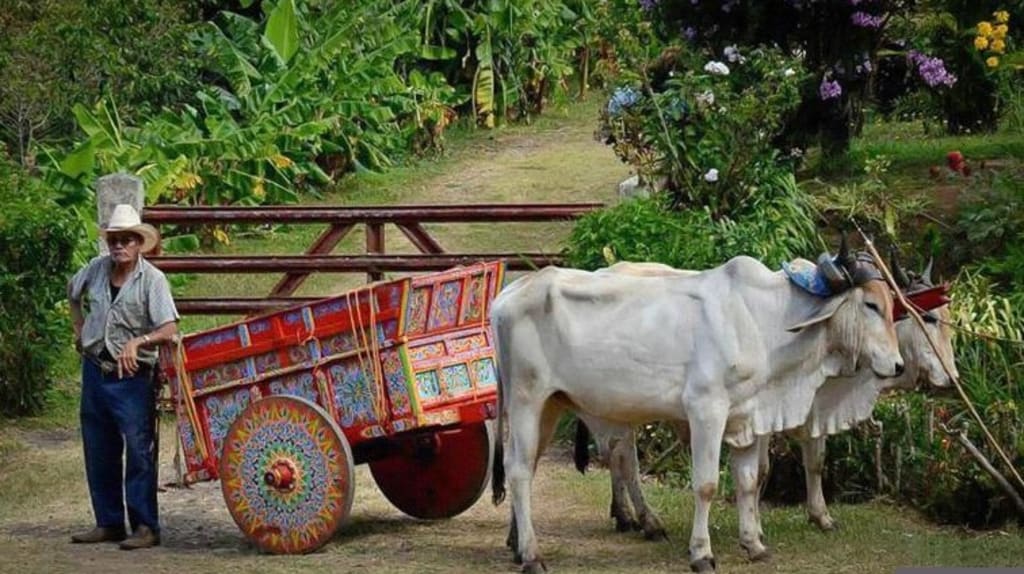The Story Behind Our Beautiful Oxcarts Here in Costa Rica. .
What a tradition it is, spun into our culture. . moving from a necessity in the 1800's to a beautiful display of what Costa Rica is all about present day. .

The oxcart was once used as the principal way to transport coffee, sugar cane, corn and pineapples across the country to both Puntarenas and Limon, two ports located on the Pacific Coast and Atlantic Coast, respectively. Oxcarts today in Costa Rica are mostly used for parades and celebrations and are indeed considered one of the icons of our Costa Rican culture.
The oxcart was originally brought over from Spain in the 1500's. They were structurally improved and made bigger here in Costa Rica. These colorfully-painted wooden oxcarts, known as "carretas" in Spanish, are now well-known around the world. Since 1988, the oxcart has been a symbol for the "National Labor Movement" here as well. It played such an important role as one of the most important of the farmers' tools throughout history.
Oxcarts were not only used in Costa Rica, but still are used in many rural areas around the world. However, the Costa Rican version of the oxcart is now famous for their unique and colorfully-painted designs, which include unique patterns, local species of flowers, many types of animals, Costa Rican landscapes and even family portraits. No two oxcarts in Costa Rica are painted the same way. Oxcart painting has been passed down in families for generations. In the town of Sarchi, located just north of San Jose, you can see a HUGE version of the oxcart, built especially to show the pride of these families. It was built in 2006 and is now displayed in the center of town. Be sure to stop by when you're in the area!
It was in Sarchi that the tradition of painting oxcarts in Costa Rica all began. The story is told that in 1902, a farmer wanted to arrive at church on Sunday mornings with his family in a more respectable and spectacular fashion than they have been for the past ten years or so. He and his family used their oxcart. . the same one that he used to take his crops to market. . to go to church. It was dirty, it stunk and it was not a good way to pay respect to the pastor and to the other parishioners. One Monday morning, he started painting his beat-up oxcart. On the following Sunday morning, the family arrived at church in high fashion! The oxcart was adorned with at least 10 different vibrant colors, with patterns of corn stalks, likenesses of their children, toucans and sloths and drawings of the sun and moon. After the service concluded, many of the churchgoers gathered around the family's oxcart. They were all in awe of such beauty! The following Sunday morning, a dozen or so oxcarts arrived, adorned with vibrant colors as well. And the NEXT Sunday, at least 50 oxcarts arrived in splendid fashion! The families living in Sarchi had a competition among themselves to see who could paint the most beautiful oxcart!
From that day forward, the tradition of oxcart painting was born. Every farmer and their families who lived around the area of Sarchi began painting all of their oxcarts and, to this day, the tradition lives on.
Getting back to the role of the oxcart in Costa Rica. . Around 1840, the growing of coffee was at its peak. Quickly, Costa Rica was becoming known around the world for its quality coffee. The coffee was in great demand globally. In the area of Sarchi, there were hundreds of coffee plantations growing some of the best coffee in the entire country. World markets opened up quickly and there was a need to expand all aspects of the coffee production here. The farmers needed a way to get their product to market and the oxcart played such an important roll. The problem was that it took over 2 weeks to get from the Central Valley area to the Port of Puntarenas and to the Port of Limon. Thousands more oxcarts were built to step up to the task at hand! By 1890, a railroad was built from the Central Valley area to the Port of Limon. That improved the transportation situation and it was a huge step in making Costa Rica even more of a player in the world coffee stage!
As a side note, the town of "Atenas" was built for the specific purpose of being a resting point or 'layover' for the weary farmers and their oxen, going from San Jose to the Port of Puntarenas. Now, Atenas is an established town. . considered one of the most beautiful locations in Costa Rica. . and is home to many Expats!
Today, many towns across the entire country honor Costa Rica’s oxcart and driver and the country's agricultural traditions. Hundreds of colorful ox-drawn carts are guided through the main streets. It is a celebration that many look forward to throughout the year! At the end of these parades, there is a huge celebration, with traditional food served and lots of dancing. Here in Costa Rica, any 'tradition' is taken seriously and serves as an integral part of the deep culture of this country.
When in Costa Rica, be sure to visit Sarchi. If you have an interest, be sure to Google, "Oxcarts in Costa Rica" and learn more about this topic. You'll be glad you did.
You're invited to visit our websites at www.costaricagoodnewsreport.com & www.costaricaimmigrationandmovingexperts.com
Also, please enjoy our over 1,700 episodes of our "Costa Rica Pura Vida Lifestyle Podcast Series". We are found on all major podcast venues, including iHeartRADIO, Spotify, Apple Podcasts, Google Podcasts, Radio FM, Anchor and many more. Here's our link: www.anchor.fm/costa-rica-pura-vida
About the Creator
William "Skip" Licht
Costa Rica is a magical place. Since November, 2002, when I first visited this country, I have been in love with the people, the culture, its biodiversity, the food. . everything about it makes me happy! Now I share my excitement with you!
Enjoyed the story? Support the Creator.
Subscribe for free to receive all their stories in your feed.






Comments
There are no comments for this story
Be the first to respond and start the conversation.